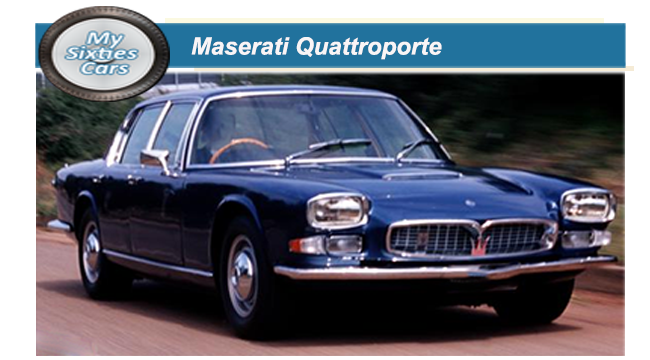
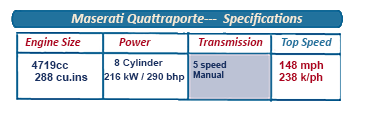 attroporte, Maserati called for collaboration between Pietro Frua, one of Italy’s leading independent design studios of the time and Vignale their long term coachbuilders .
Having evolved rapidly from a company who only produced all-out race cars to sports-racers to makers of exotic sports cruisers, Maserati had now turned to a four-door sedan.
Yet the Qu
attroporte, Maserati called for collaboration between Pietro Frua, one of Italy’s leading independent design studios of the time and Vignale their long term coachbuilders .
Having evolved rapidly from a company who only produced all-out race cars to sports-racers to makers of exotic sports cruisers, Maserati had now turned to a four-door sedan.
Yet the Qu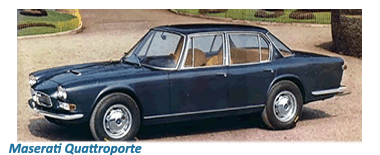 attroporte was far from being a run of the mill sedan, but a four-seat GT near-supercar, with Pietro Frua having created with an intriguing collection of curves and angles.
The Quattroporte’s cabin was roomy and tall, offering considerable leg room for the driver and up to four passengers.
Visibility was excellent, thanks to Frua’s design based around a tall cabin with a very sizable glass area, causing the model to sometimes described as “ the Greenhouse”.
attroporte was far from being a run of the mill sedan, but a four-seat GT near-supercar, with Pietro Frua having created with an intriguing collection of curves and angles.
The Quattroporte’s cabin was roomy and tall, offering considerable leg room for the driver and up to four passengers.
Visibility was excellent, thanks to Frua’s design based around a tall cabin with a very sizable glass area, causing the model to sometimes described as “ the Greenhouse”.
![]()
A split grille held the usual Maserati trident in its centre, in a protruding front end.
Models destined for Europe initially were fitted with rectangular headlamps while later versions (especially those exported to the U.S.) came with quad round headlights. Maserati i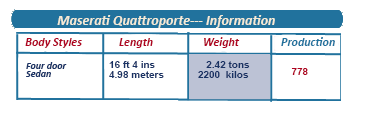 nitially launched the Quattroporte with a 4.2-litre V-8 fed by four Weber carburettors, enough to generate 260 bhp matched up to a five-speed gearbox.
nitially launched the Quattroporte with a 4.2-litre V-8 fed by four Weber carburettors, enough to generate 260 bhp matched up to a five-speed gearbox.
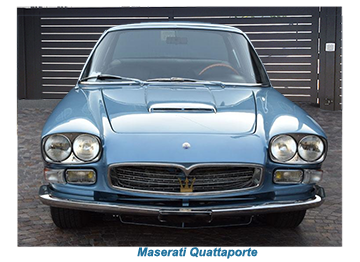 This combination was rapidly discovered to be sorely underpowered, far from capable of powering the bulky and heavy Quattroporte. It was replaced by a 4,719 cc V-8 engine with quad overhead camshafts that generated around 300 bhp to give top speeds of about 150 mph (240 kph).
This combination was rapidly discovered to be sorely underpowered, far from capable of powering the bulky and heavy Quattroporte. It was replaced by a 4,719 cc V-8 engine with quad overhead camshafts that generated around 300 bhp to give top speeds of about 150 mph (240 kph).
 Down below was a tubular and box-section chassis, with all-disc brakes. A De Dion rear axle was installed at first, although this configuration proved troublesome in operation.
Down below was a tubular and box-section chassis, with all-disc brakes. A De Dion rear axle was installed at first, although this configuration proved troublesome in operation.
![]()
By 1966, the axle had been replaced by a conventional live axle with semi-elliptic springs.
Maserati s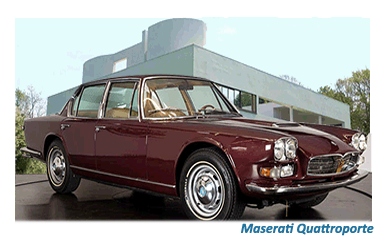 tarted a new trend in Italian exotica with its Quattroporte of 1963, providing a reasonable alternative to the more sedate Mercedes and Rolls-Royces that had traditionally dominated the market for luxury saloons,
tarted a new trend in Italian exotica with its Quattroporte of 1963, providing a reasonable alternative to the more sedate Mercedes and Rolls-Royces that had traditionally dominated the market for luxury saloons,
The saloon supercar concept, combining luxury comfort with superb performance, was a theme that would be later adopted by Lamborghini with their Espada and Ferrari with the 365 GT4 2+2.
Despite being out on a tangent, the Quattroporte even succeeded in attracting some very prestigious owners, with the best know of them Prince Rainier III of Monaco.





